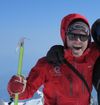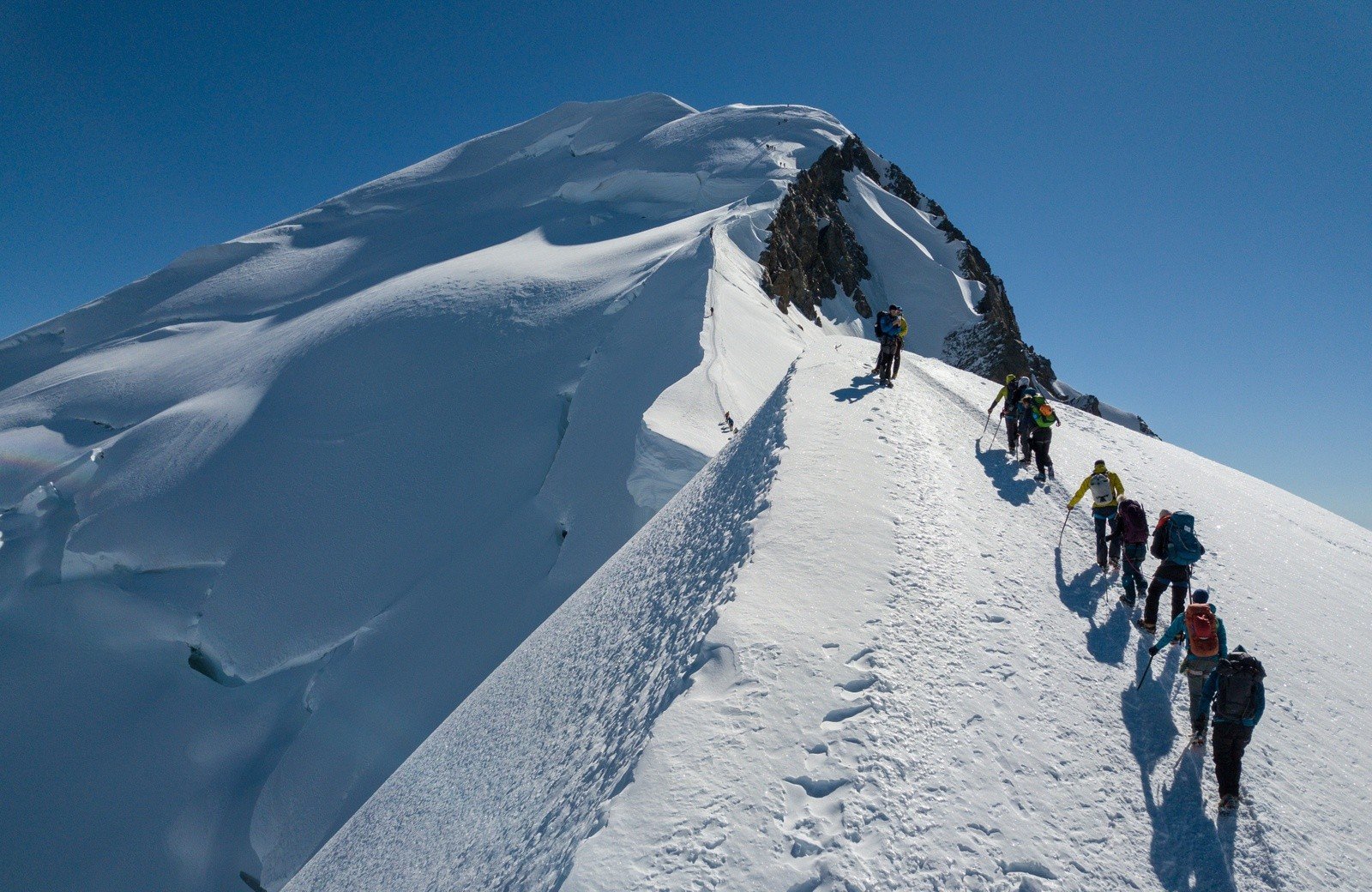
So, you want to climb Mont Blanc? Here, Chamonix local and mountain expert Olly Alkema talks us through what it's like to climb to the highest point in western Europe - looking out over all of the Alps.
Mont Blanc sits on the border between France and Italy in the Alps and, since the first Mont Blanc ascent in 1786 by local mountaineers Jacques Balmat and Dr Michel-Gabriel Paccard, is widely considered to be the birthplace of modern mountaineering. It's a peak that has inspired everyone from the romantic poets - Byron referred to it as the "monarch of mountains" - to contemporary Alpinists.
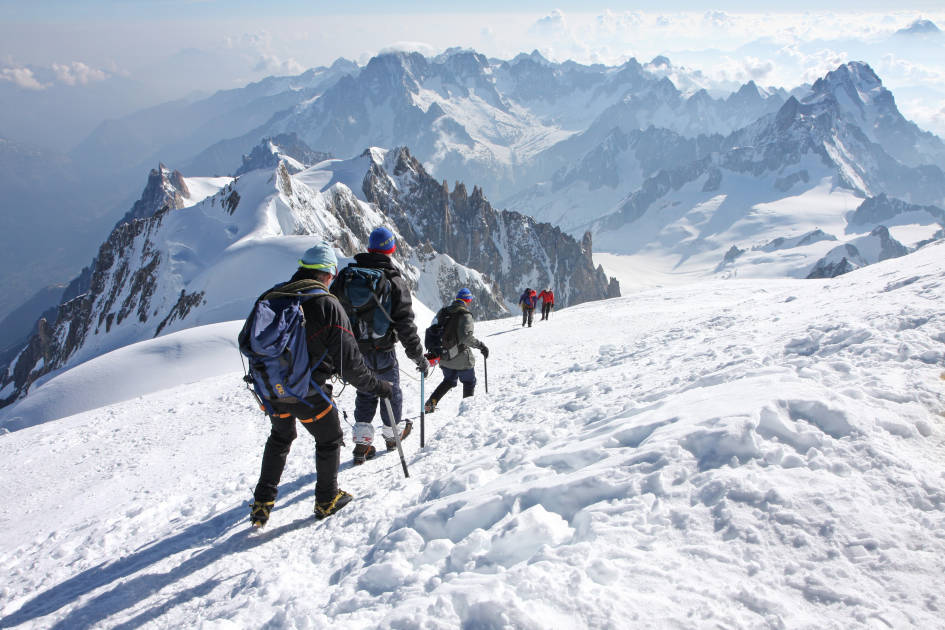
Looming large over the mountain town of Chamonix, its sky-piercing, glaciated beauty and relative accessibility make it a challenge any wannabe mountaineer can realistically aspire to. With an experienced mountain guide, a good level of fitness and the right mindset it is certainly achievable for most.
In this guide, we'll be discussing the various routes up Mont Blanc, the gear and equipment you need, and answering frequently asked questions about this mighty peak.
Where is Mont Blanc?
Situated in the Alps, Mont Blanc straddles the French-Italian border and also extends into Switzerland. The massif stretches southwest from Martigny, Switzerland, for about 25 miles (40 km) to Moûtiers in France. Mont Blanc's summit lies between the valleys of Ferret and Veny in Italy, and the valleys of Montjoie, and Arve in France.
The region around the massif includes the Graian Alps to the south, the Chamonix Valley and Savoy Alps to the west, the Pennine Alps to the northeast, and the Valley of Courmayeur to the east. Other notable peaks within the massif include Mont Blanc du Tacul, Les Grandes Jorasses, Mont Dolent, and Aiguille du Midi.
How High is Mont Blanc?
The height of Mont Blanc is 4805 metres (15764 feet) - five metres lower than when it was last measured in 2013. That's 0.38 metres less than 2011, and 3 metres more than the 4807 metres originally recorded back in 1863.
As the highest point in Western Europe, it’s by no means a walk in the park though, and remains a rite of passage for many alpinists worldwide.
Climb Mont Blanc: The Goûter Route via the Dôme du Goûter
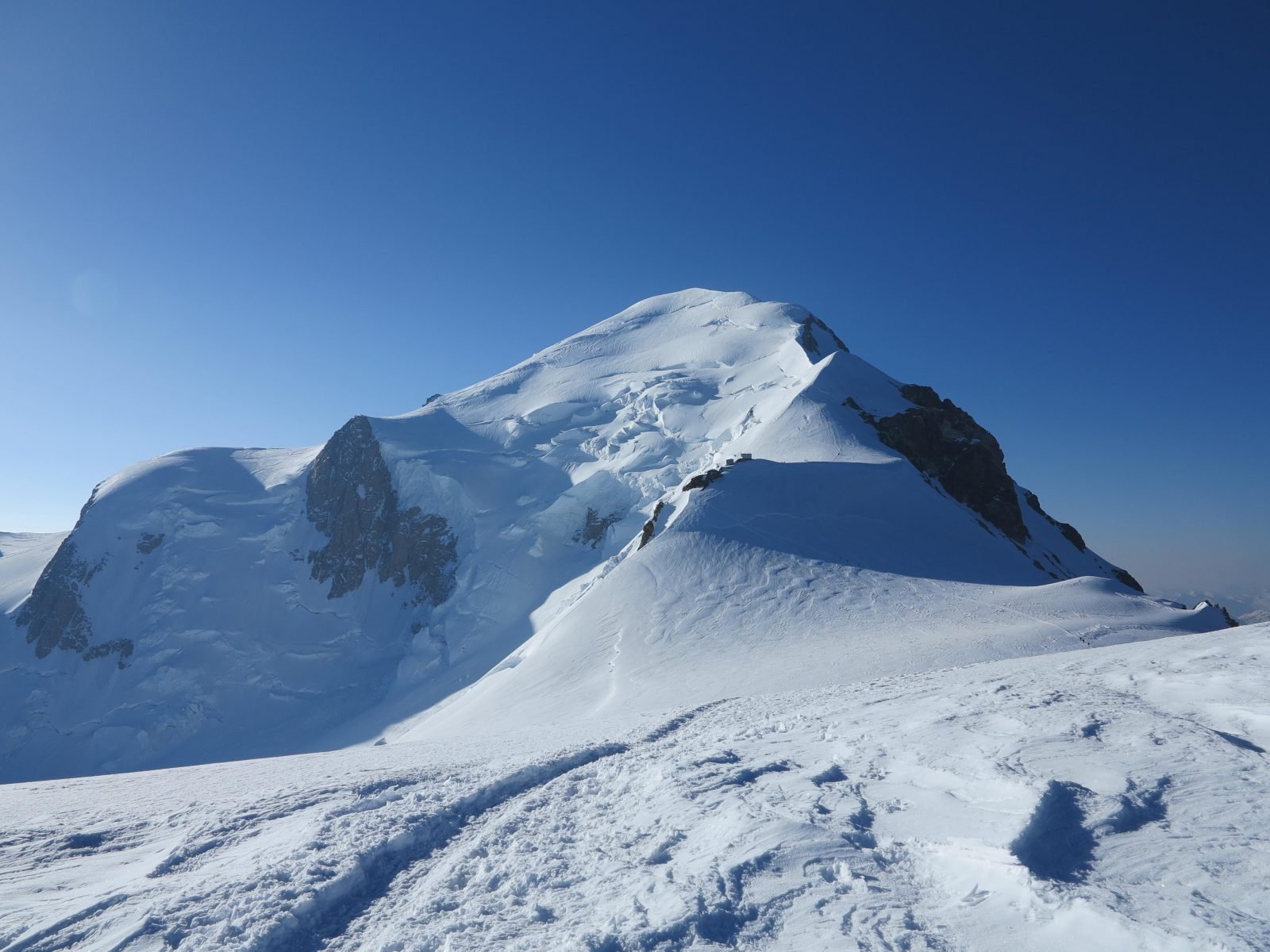
There are many many ways to climb Mont Blanc. The difficulty of ascent varies across the various Mont Blanc routes but the most common route - the Goûter Route via the Dôme du Goûter - is manageable with some previous trekking and/or mountaineering experience, a good head for heights, a willingness to learn new skills, a decent level of fitness and a heavy dose of determination.
The Goûter Route has become the ‘voie normale’ route to summit Mont Blanc, even though the first ascent took a very different path back in 1786. Starting from Les Houches and going via the Refuge de Tete Rousse and Refuge du Goûter, this is considered to be the least technical route to the summit. For that reason, it’s also the route used on our classic Climb Mont Blanc trip.
It's also worth noting that most guided climbs of Mont Blanc won't take you directly up to the summit - you'll spend a few days learning some basic mountaineering skills and doing some acclimatisation hikes in the surrounding mountains. Climbing Tête Blanche (3429m) - with an ascent up a rocky ridgeline carpeted in snow - is an ideal warm up ahead of Mont Blanc. The route description of the 'voie normale' below doesn't include this training and acclimatisation, as each tour will offer slightly different options.
Day 1: Les Houches to Tête Rousse
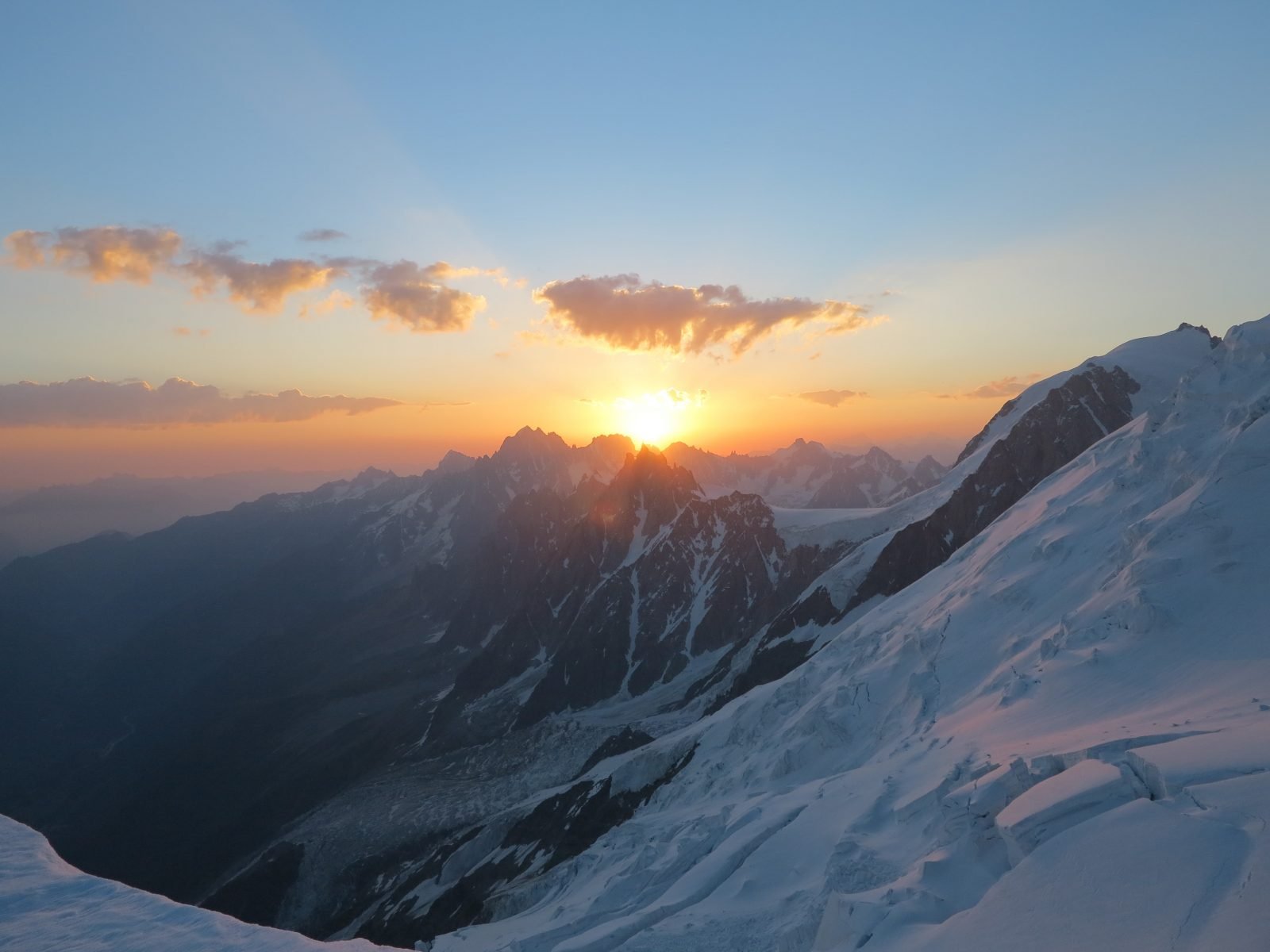
- Hiking time: 2-3 hours
- Distance: 2.4 miles (4km)
- Ascent: 800m up
Starting in the village of Les Houches, 8km from Chamonix, you take the Bellevue cable car up to 1800m. From here you take the old Tramway du Mont Blanc train up to the Nid d’Aigle at 2372m where the hike begins to one of the two huts en route to the summit. The Refuge de Tete Rousse sits at 3167m and is a popular choice for the first night of the ascent. Hiking here takes between 2 and 3 hours over fairly easy terrain with beautiful views down to the Chamonix Valley and the Aravis mountain range in the distance.
Day 2: Tête Rousse to Mont Blanc Summit and the Refuge du Goûter
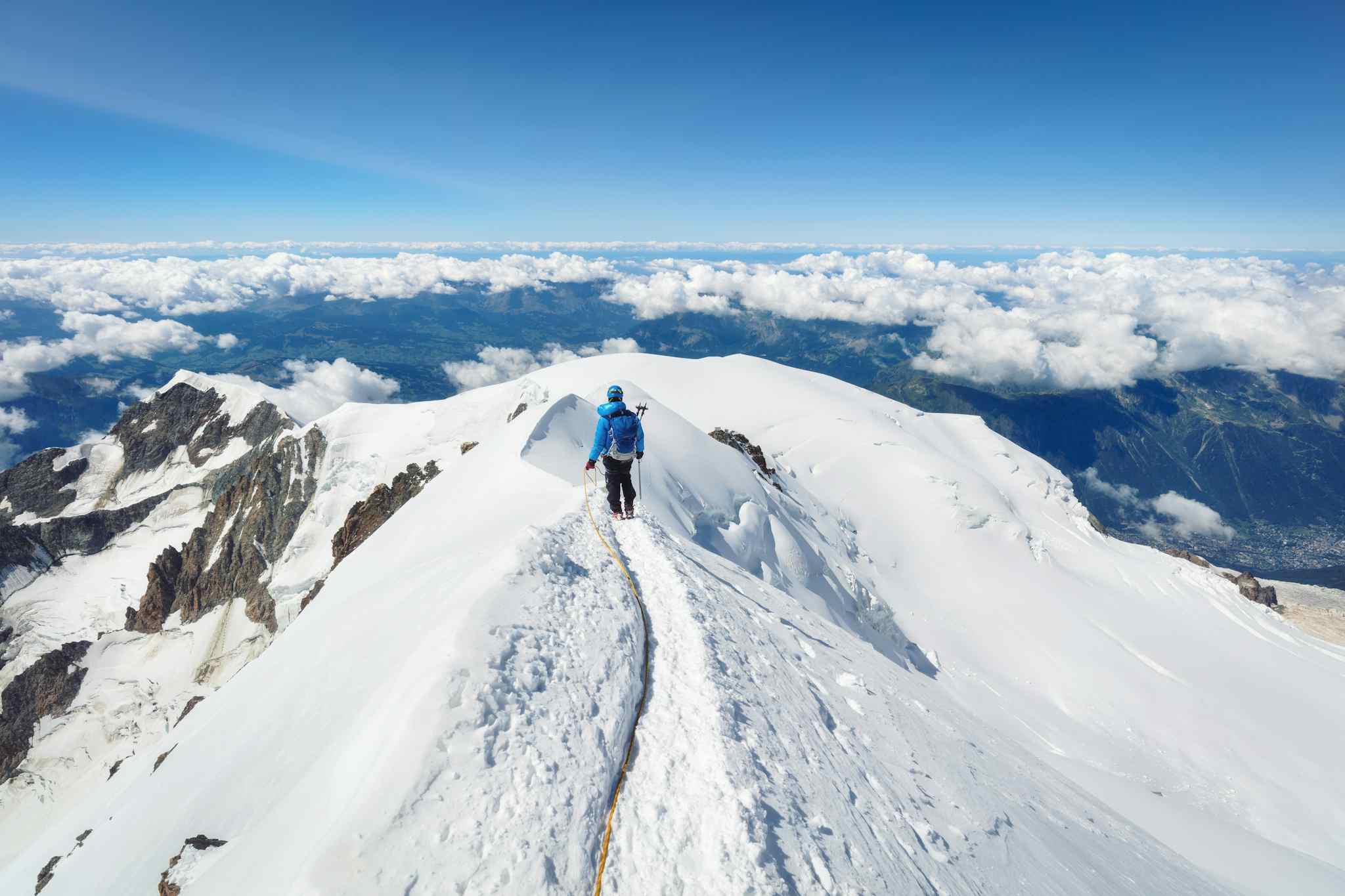
- Hiking time: 11-14 hours
- Distance: 6.2 miles (10km)
- Ascent: 1600m up/1000m down
An early departure the next morning from Refuge de Tete Rousse sees you climb up to the Refuge du Goûter via a 700m high rock face that ascends next to the Gouter grand couloir, notorious for rock fall in warm temperatures. This section requires good scrambling techniques and rope work with your guide as well as prudence.
Once at the Refuge du Goûter at 3835m you reach the mellower upper snow slopes of Mont Blanc, where crampons are required for the rest of the ascent on the glaciated slopes towards the summit. Continuing from the Refuge du Goûter you ascend the Dome du Goûter to 4304m before reaching the Vallot emergency shelter at 4362m. From here the ascent takes the Bosses ridge to the summit with spectacular views in all directions. The ridge can be narrow and very exposed at times, requiring total concentration and skill to ascend and, more importantly, to descend soon after.

At the summit, depending on the weather, you can normally stay there for a few minutes before starting the descent. The view is simply breathtaking. You can see deep into the Italian, Swiss and French Alps and a never-ending horizon greets you in all directions. It’s been known that on a very clear day you can even see the Mediterranean in the distance. You truly feel like you’re on top of the world and it is a feeling that will stay with you for a lifetime.
Normally people will either descend to the Refuge du Goûter, or to the Refuge de Tete Rousse for a particularly long day - we recommend the former.
Day 3: Refuge du Goûter to Les Houches
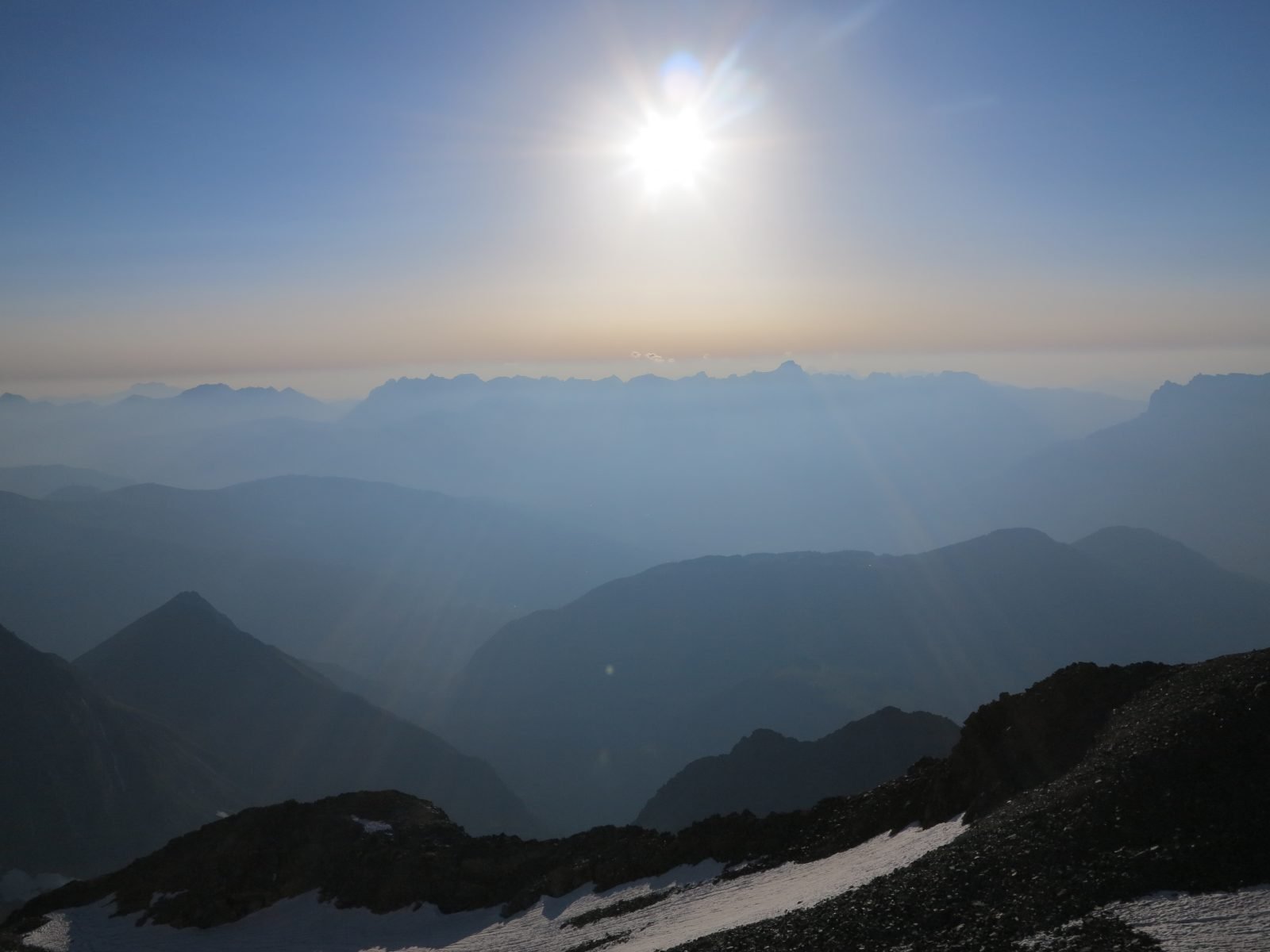
- Hiking time: 3-4 hours
- Distance: 3.1 miles (10km)
- Ascent: 1400m down
Return along the same path from Refuge du Goûter to the start point of the hike. From here, you'll be able to get public or private transport back to Chamonix.
Alternative Routes to the Summit of Mont Blanc
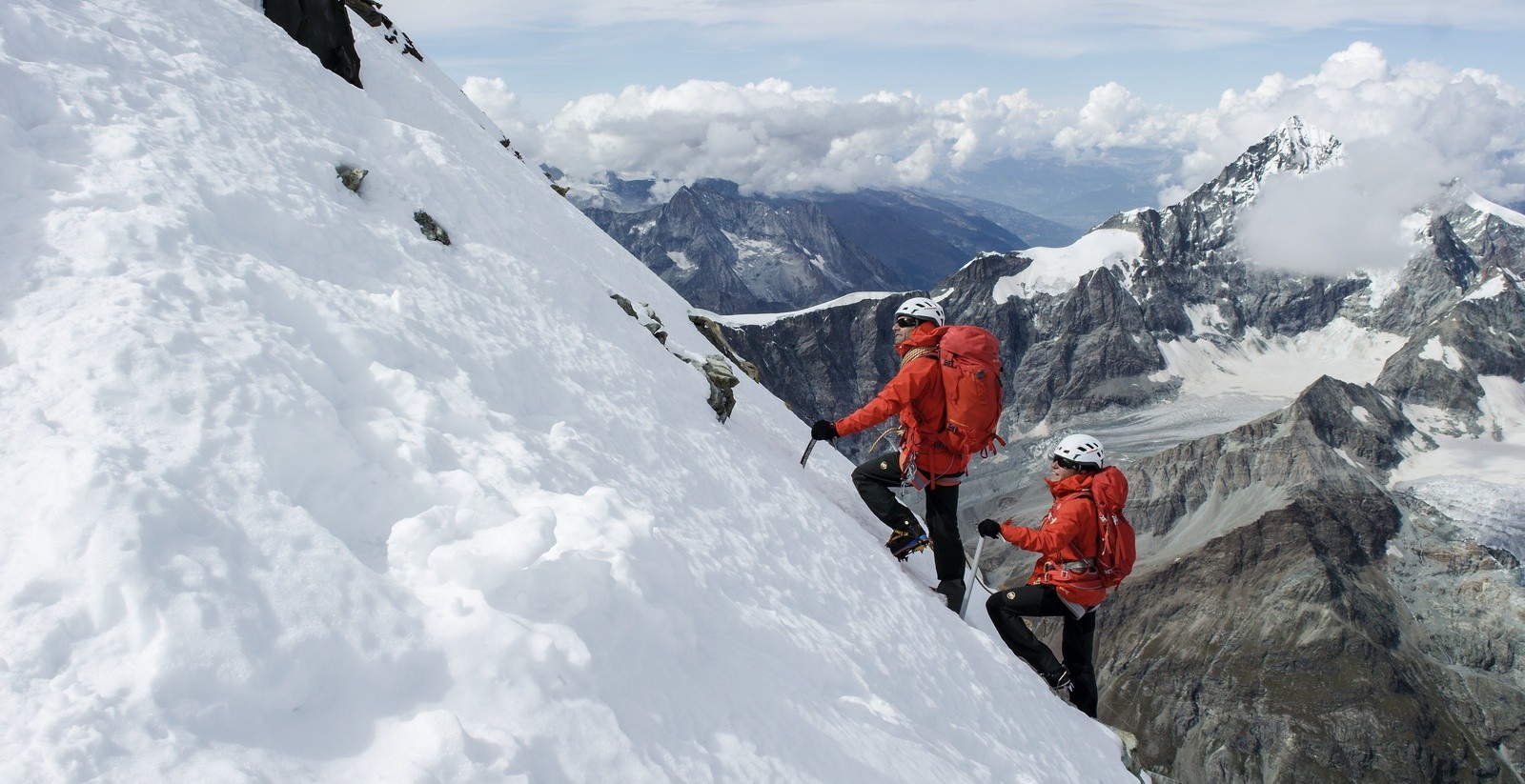
Here are some quick summaries of alternative routes to the summit, with different start points. Many of these are more technical than the voie normale - even experienced climbers should go with a guide.
Trois Monts Route
Starting from the Aiguille du Midi station at 3842m, you climb via Mont Blanc du Tacul and Mont Maudit to the summit. This is more technical than the Gouter Route and requires 1:1 guiding. The descent can be done the same way or via the Refuge du Gouter and down the Gouter Route to Les Houches.
Italian Route via the Gonella Hut
This is a spectacular and quieter alternative to the Gouter Route although it is normally only in condition in the early summer months of May, June and July. Starting in the Val Veny, you ascend the Miage Glacier to the Gonella Hut and on summit day you ascend to the Col de Bionnassay and then join the normal Gouter Route to the summit.
Grand Mulets Route
This is the original route taken by Jacques Balmat and Dr Michel Paccard in 1786, which takes the most direct line up to the summit as viewed from Chamonix. Nowadays people will start by taking the cable car to the Plan de l’Aiguille station and cross the Bossons Glacier to the Grand Mulets Hut which sits at 3051m. From here you ascend to the Col du Dome which is exposed to crevasses and serac fall, before joining the Bosses ridge to the summit. This route is commonly used for ski touring in spring for those aiming to ski from the summit of Mont Blanc.
How Hard is it to Climb Mont Blanc?
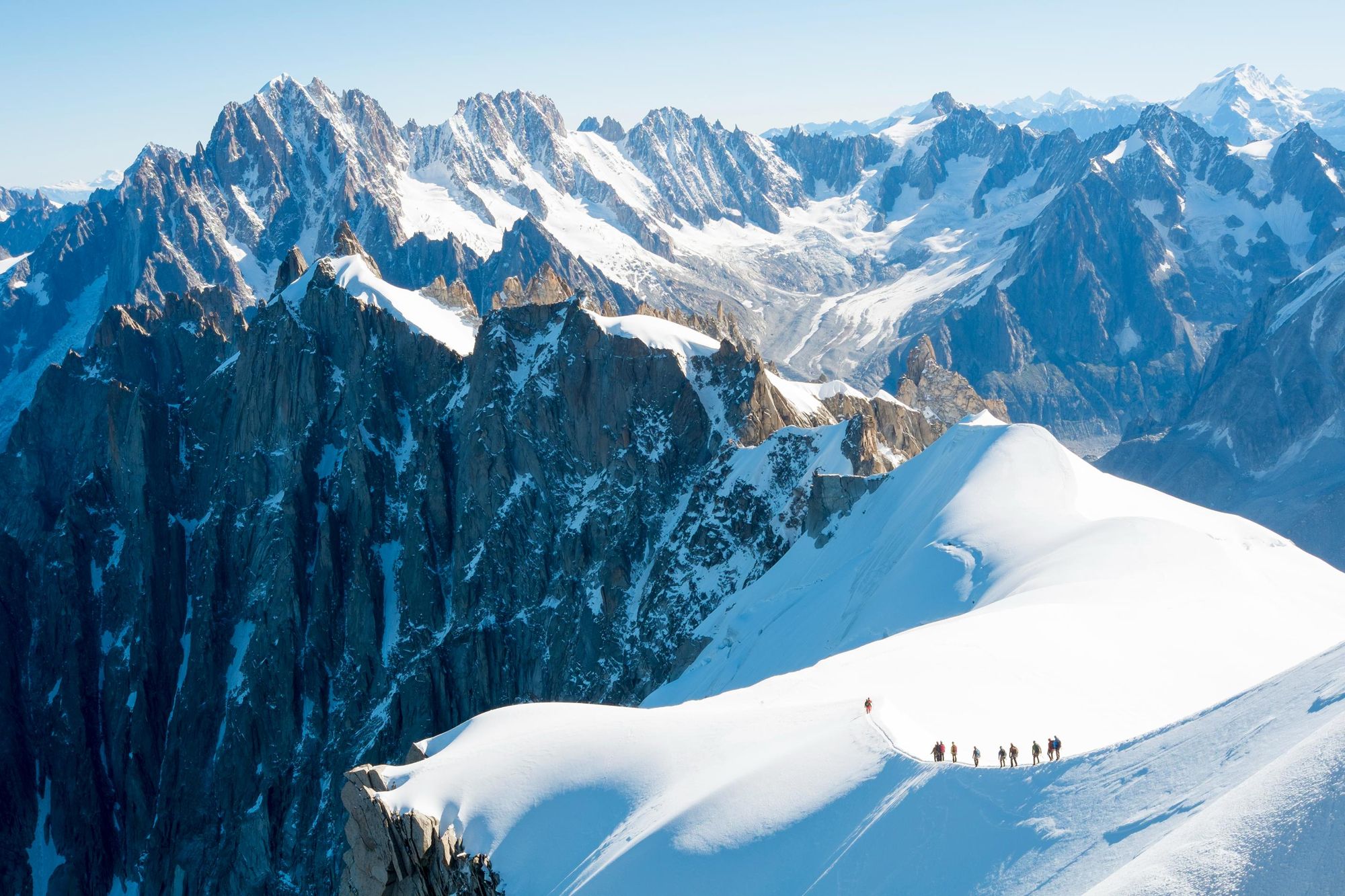
Climbing Mont Blanc is not easy. People often ask if climbing Mont Blanc is harder than climbing Mount Kilimanjaro, the highest mountain in Africa. While Kilimanjaro might be higher at 5,895m, make no mistake, climbing Mont Blanc is significantly more difficult.
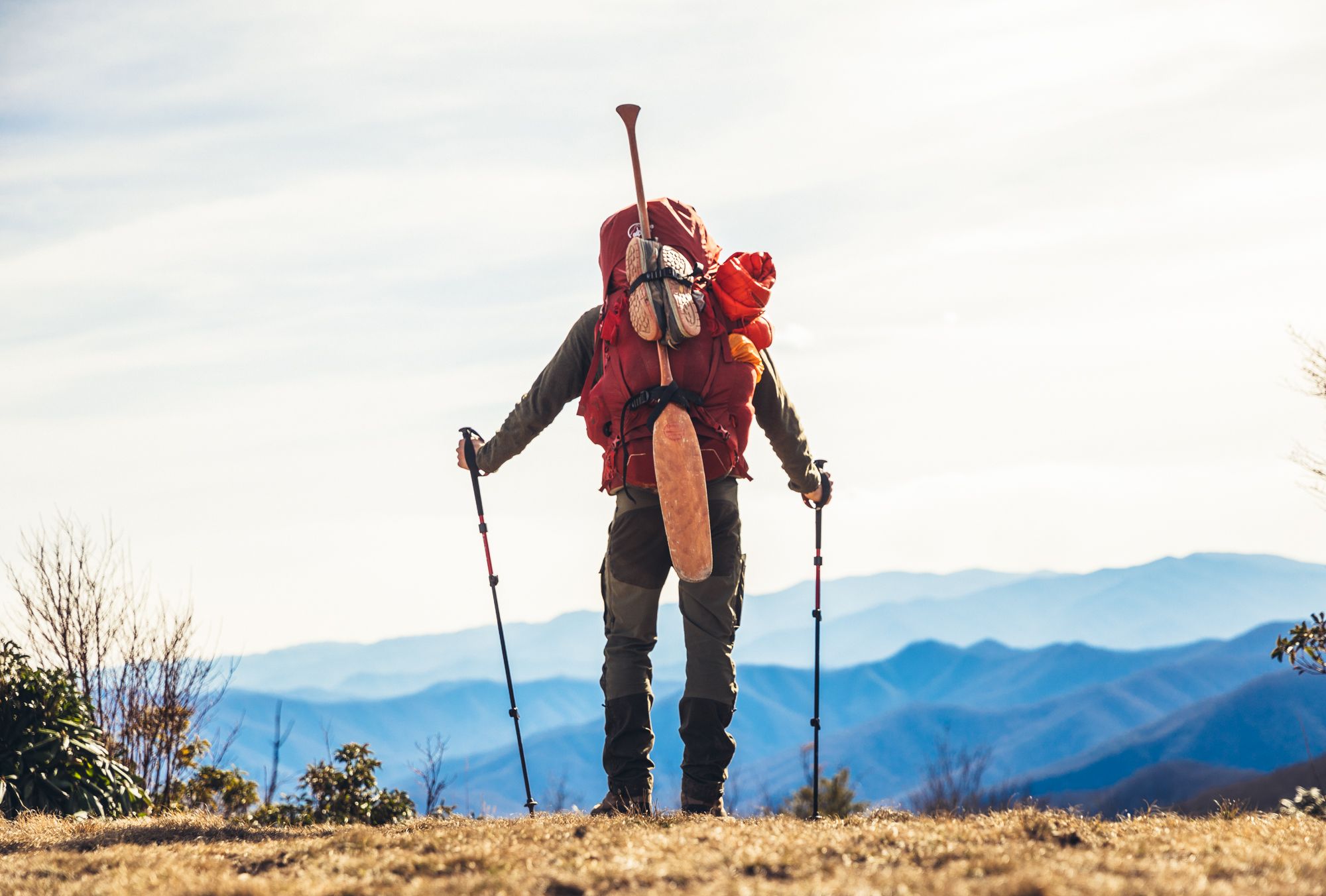
You will need to be extremely fit to climb Mont Blanc. Many guides recommend training in the hills and mountains for months before climbing - hiking with a backpack for hours at a time, attempting steep climbs, and climbs at altitude, when possible, and making sure you're able to spend 10-15 hours on your feet, hiking.
You'll want to do endurance training, while also working on your strength.
So, is Mont Blanc beginner-friendly? It may not sound like it from all that, but actually, previous technical mountaineering experience isn't essential. Realistically, of course, the more mountain experience you have the better your chance of making the summit. This is not a mountain to underestimate.
Consider a winter skills course (learning to use kit like ice axes, crampons and focusing on winter navigation), then tackling some lower mountains in the Alps before taking on the biggest mountain in western Europe.
Can you Climb Mont Blanc Without a Guide?
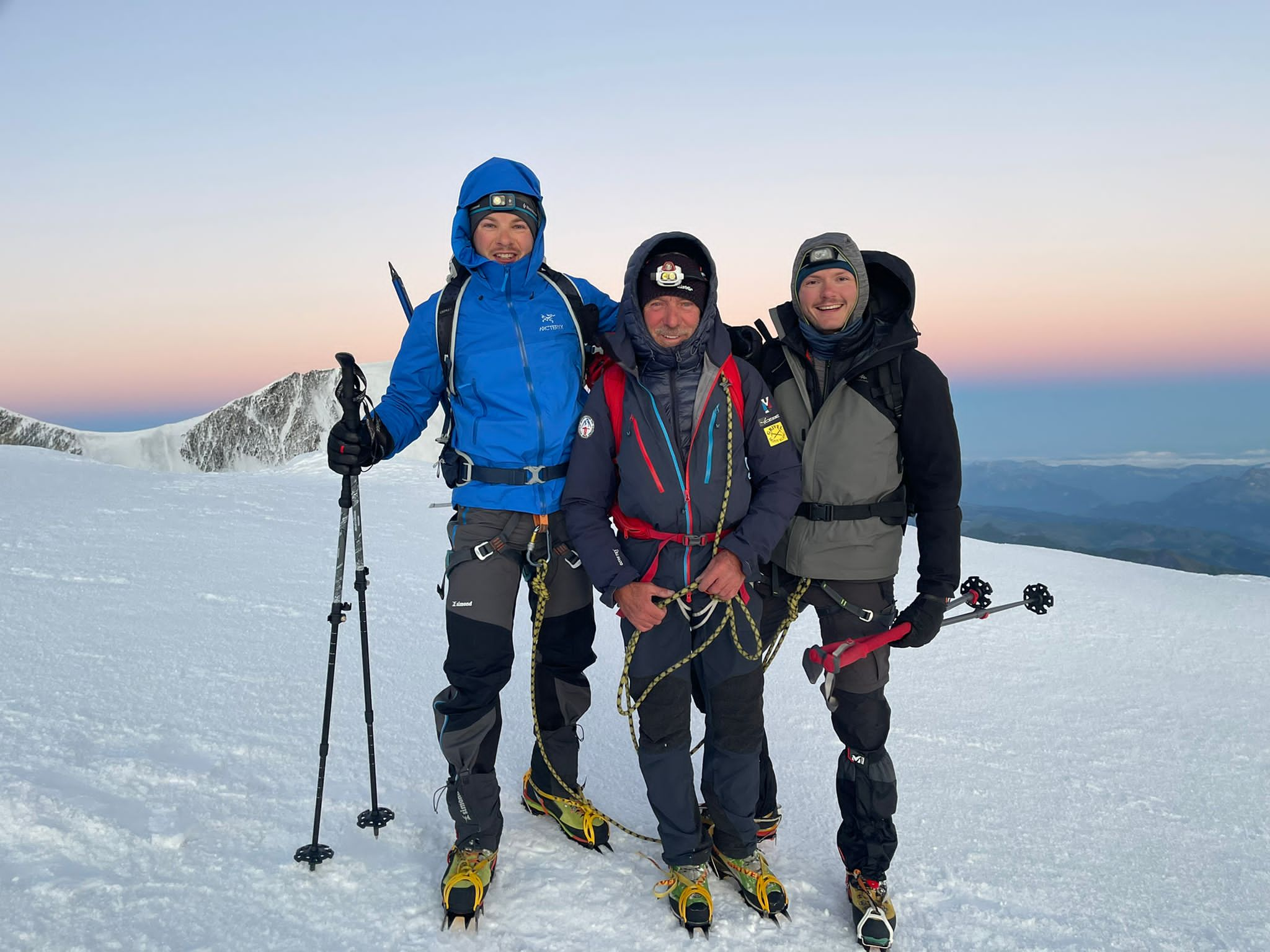
You are technically allowed to climb Mont Blanc without a guide, but doing so without extensive alpine mountaineering experience would be a bad, even potentially fatal, decision. All guides on Mont Blanc will be members of the IFMGA (International Federation of Mountain Guides Association), and so when you do hire an accredited guide, you'll be in safe hands. It's strongly recommended.
Mont Blanc may not be the most technical climb in the world, but it's still the tallest in the Alps, and one of the most dangerous in the area. This isn't a mountain you should climb at a few days notice. Prepare properly, train, and follow the advice of an expert guide. Then you'll have a good shot at making it to the summit - and back down safely.
How Long Does it Take to Climb Mont Blanc?
While a few people have been known to run up it in a day(!) a guided Mont Blanc summit hike typically takes 3 days. The first day for the ascent to the first hut (3-4hrs), the second day for the summit attempt and descent to the second hut (8-10hrs), and the third day for the descent back to the valley (4-6hrs).
It’s common to do a 6 or 7-day Mont Blanc package to include training and acclimatisation before a 3-day ascent to the summit. It’s a brilliant week packed full of amazing trekking and climbing on top of Mont Blanc itself, while learning or refreshing all sorts of skills.
When is the Best Time to Climb Mont Blanc?
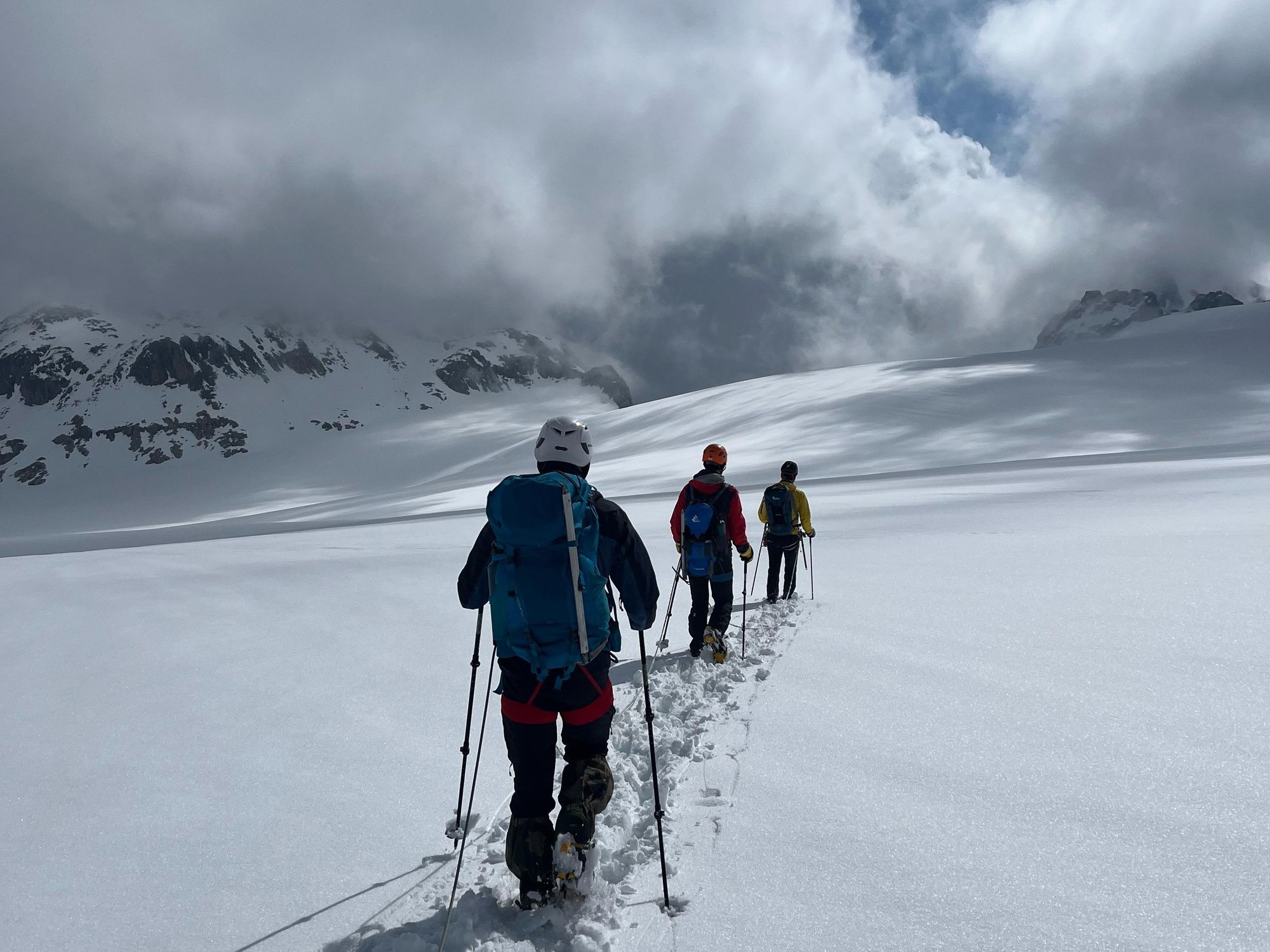
The best time to climb Mont Blanc is from late May to the end of September. This is the climbing season, in large part due to the favourable summer weather, and as such, it also correlates with the opening times of the Refuge de Tete Rousse, Refuge du Gouter and Refuge des Cosmiques. There is no better or worse time to attempt the climb during this period, however early and late summer can mean cooler temperatures, whilst mid-summer can be particularly warm.
A successful attempt is based on many factors coming together; stable weather, safe conditions and managing to get hut reservations (which won’t be a problem if you take the hassle-free route of joining a guided trip). Trying to get a booking in the huts, especially the Gouter hut, can be very difficult and turning up without a reservation is strictly prohibited.
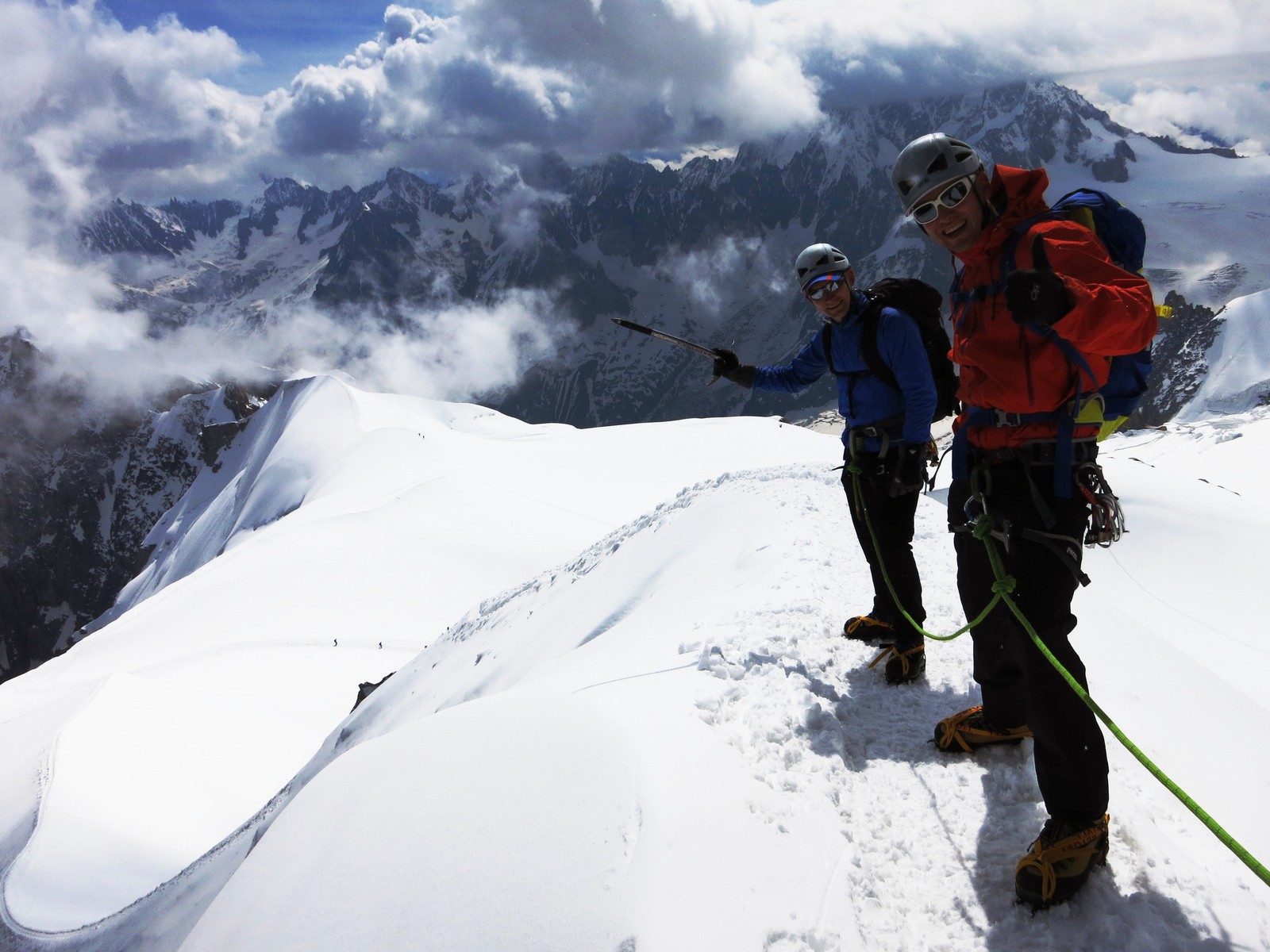
How Dangerous is it to Climb Mont Blanc?
Be under no illusions. While many people successfully summit every day, this is still a serious mountain, with very real dangers.
All routes have their own unique threats, with even the classic Gouter route exposing climbers to rockfall in the Grand Couloir. Other dangers present across all routes include serac falls (falling chunks of ice), falling into crevasses (cracks in the glacier), fast changing weather and avalanches. Being with an experienced guide significantly improves your safety levels, but no-one should ever think they are immune from the dangers of mountain climbing. It comes with the territory.
If you're looking for to experience Mont Blanc and the Alps on a safer route, consider walking the Tour du Mont Blanc...
But before you close this window and start looking for holidays on the beach in Greece, remember the odds we just looked at are good, and that with a little risk, comes great reward.
Accidents tend to happen when care isn’t taken and this can often sadly happen in un-guided parties. Therefore, it is highly recommended to climb Mont Blanc with a guide to get the most out of the experience. It is a once in a lifetime climb for some, and it is an achievement that everyone will be proud of.
If you're looking for to experience Mont Blanc and the Alps on a safer route, consider walking the Tour du Mont Blanc, which circumnavigates the mountain.
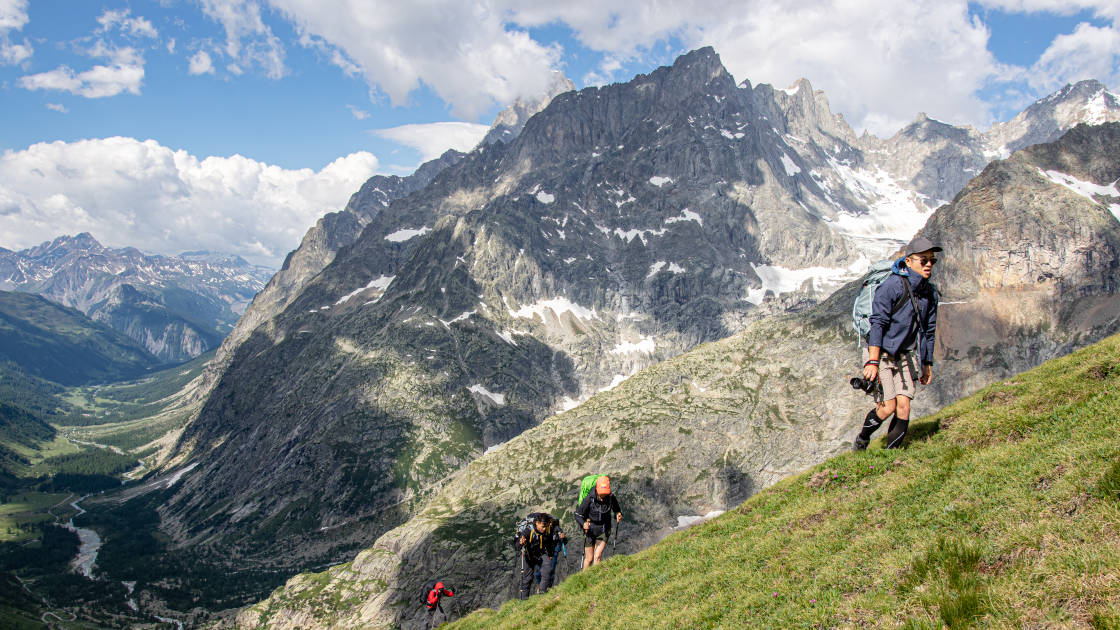
Mont Blanc Packing List
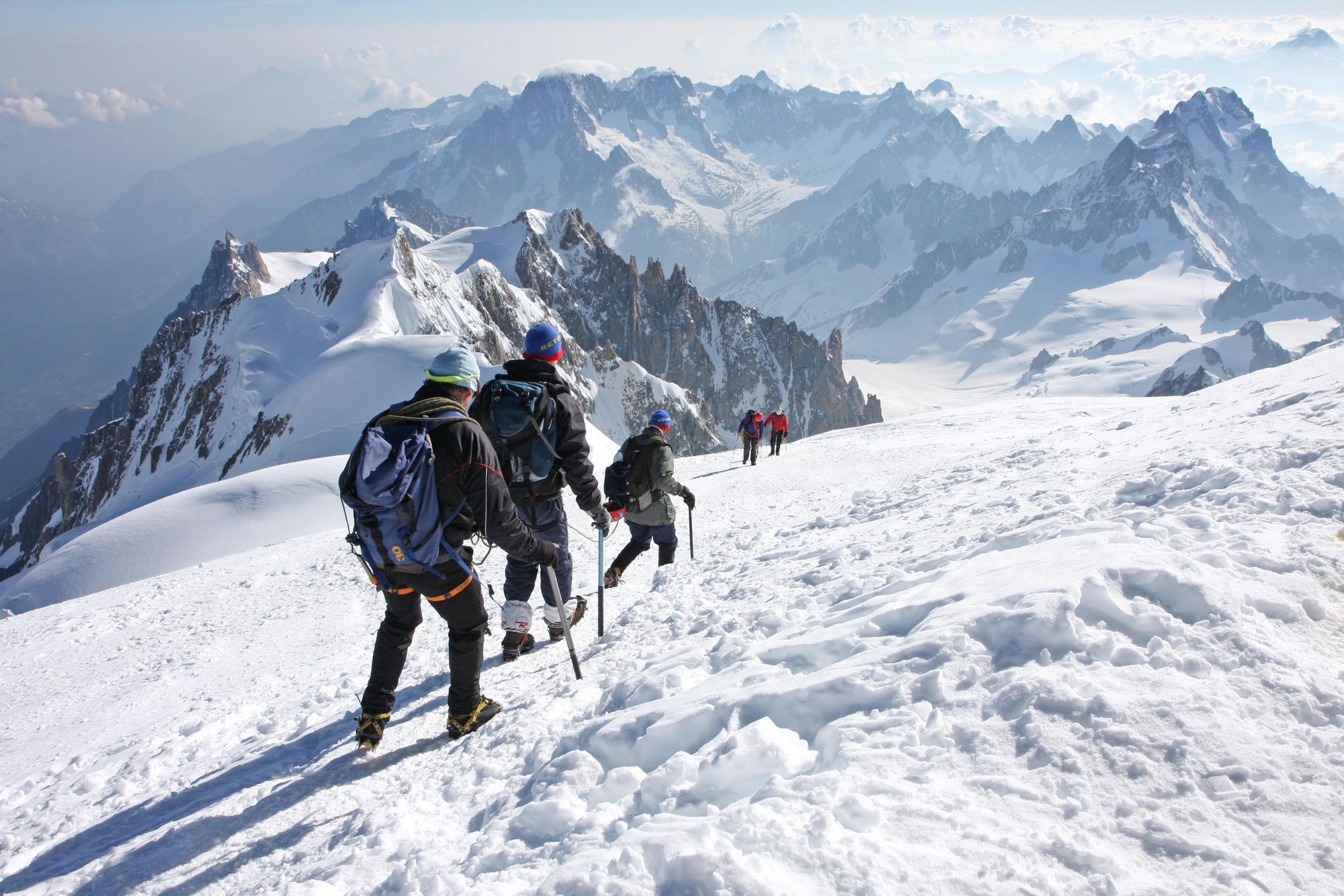
A range of good quality mountaineering clothing is required, including protective hardshell and soft shell pants and jackets, thermal layers and strong sun protection. The technical items that are required include mountaineering boots, crampons, ice axe, hiking poles, harness and helmet. These items can be rented locally and full kit lists will be provided by your guide. Still, here's a sample list:
Equipment
- Ice axe for general mountaineering (between 50-70cm depending on height)
- Standard, steel mountaineering crampons
- Hard plastic climbing helmet
- Climbing harness (adjustable, to fit over layers), with two screw-gate carabiners
- Foldable trekking poles
- Rucksack – Mountaineering specific (ice axe strap, rainproof cover), 30-50L
Clothing
- Mountaineering B2 or B3 boots and gaiters, compatible with crampons
- Socks and thermal tops
- Lightweight hardshell hooded top and bottoms
- Warm hat
- Gloves (one pair of thick mountaineering gloves and one thinner pair)
- Insulating layers: a lightweight fleece and a synthetic or down jacket
- Mountaineering trousers
- Shorts, hiking shoes and trainers (to wear around town pre/post-hike)
Other
- Earplugs
- Water bottles, up to 2L
- Sun protection: sunglasses (category 4), goggles, sun hat, factor 30-50 high mountain sunscreen, lip salve/block
- Head torch and spare batteries
- Sleeping bag silk liner (sleeping bag and blankets/duvets provided in huts)
- Personal first aid – blister kit, aspirin, or paracetamol
- Cash for extra drinks/snacks in huts
As they say in Chamonix, it is impossible to take a bad photo in these beautiful mountains, so don’t forget your camera!
Climb Mont Blanc Cost
The cost of climbing Mont Blanc can vary quite considerably based on the number of days in the summit program and what that cost includes. If you decide to go with a guided package, you are looking at between £2,500 - £3,500, but do check the small print to see what that price includes as they all differ substantially. Things to look out for include; accommodation on the valley floor, accommodation in the mountain huts, guide fees and expenses, lift to the Aiguille du Midi, kit rental, tram fees, airport transfers and meals.
How to Get to Mont Blanc
Most Mont Blanc trips begin from either Chamonix (France) or Courmayeur (Italy). Most guides operate out of Chamonix, which is easiest to get to from Geneva Airport via shuttle bus or transfer (1hr).
Read More:
- The Beginner's Guide to Trekking the Tour du Mont Blanc
- The 10 Highest Mountains in Europe
- The Guide to Climbing Mount Toubkal
Inspired? Check out our Mont Blanc adventures, run by experienced local mountaineering guides.

